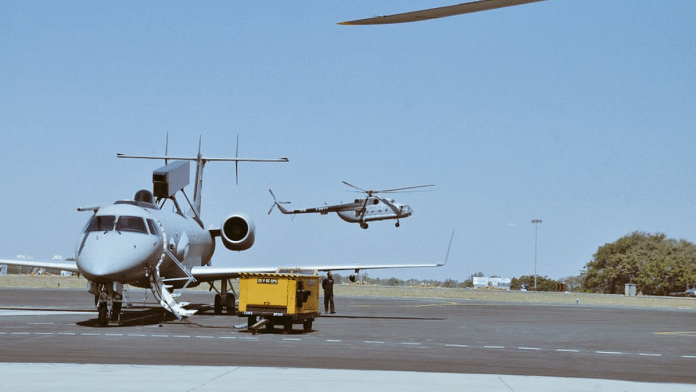New Delhi: The Defence Ministry on Thursday approved the procurement of six additional Airborne Early Warning & Control (AEW&C), which would be an upgraded version of the current two in-service India-developed systems called the Netra.
The new system is likely to be fitted on board six Embraer aircraft like the existing two. India operates three AEW&C, of which one is operated by the Centre For Air Borne System (CABS), which comes under the Defence Research and Development Organisation (DRDO).
Known as the ‘eyes in the sky’, the AEW&C can detect and track all flying objects, including incoming fighters, cruise missiles and drones, faster than ground-based radars. They can also act as an aerial control room for missions while also keeping track of ships out at sea.
The Defence Acquisition Council (DAC) clearance for AEW&C is significant as the Indian Air Force (IAF) needs to induct more systems at the earliest.
The air force plans to induct six more Netra systems including Netra Mk1A, besides possible replacement for the two it currently operates. Also, there are plans to induct another six AEW&C systems being developed by the DRDO and to be mounted on Airbus A321 aircraft, which will be known as Netra Mk2.
Six of these aircraft for Mk2 have been procured from Air India and are currently with the communications squadron of the IAF. These aircraft will be fitted with India made indigenous Active Electronically Scanned Array (AESA) radar.
India also operates three Air Borne Warning and Control Systems (AWACS), which are integrated with the Russian Il-76 aircraft.
Pakistan, on the other hand, operates nine state-of-the-art Saab 2000 Erieye AEW&Cs, besides the four Chinese ZDK03 Karakoram Eagle AWACS. Given its size, Pakistan has the capability to carry out round-the-clock surveillance, a capability not present with India currently.
The criticality of the AEW&C was felt during the aerial duel between India and Pakistan on 27 February 2019. Pakistan, which then had six Saab 2000, took advantage of IAF’s changeover of the ‘eye in the sky’, when launching the attack.
While India’s Netra currently has a range of about 200 km, the Il76-based system has a range of 400 Km and has a 360 degree coverage to a slightly lesser one for the former. It is understood that the Netra Mk 1A and the Mk2 will have much higher range and capabilities.
This is an updated version of report. RAW has been replaced with Centre For Air Borne System (CABS) in the second para.
(Edited by Tony Rai)
Also Read: Overheard in Aero India: IAF chief AP Singh says ‘not confident of HAL, it’s not in mission mode’






